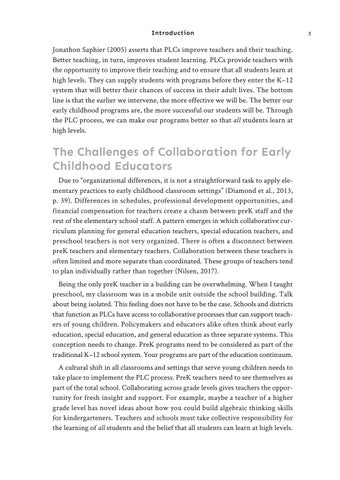Introduction
Jonathon Saphier (2005) asserts that PLCs improve teachers and their teaching. Better teaching, in turn, improves student learning. PLCs provide teachers with the opportunity to improve their teaching and to ensure that all students learn at high levels. They can supply students with programs before they enter the K–12 system that will better their chances of success in their adult lives. The bottom line is that the earlier we intervene, the more effective we will be. The better our early childhood programs are, the more successful our students will be. Through the PLC process, we can make our programs better so that all students learn at high levels.
The Challenges of Collaboration for Early Childhood Educators Due to “organizational differences, it is not a straightforward task to apply elementary practices to early childhood classroom settings” (Diamond et al., 2013, p. 39). Differences in schedules, professional development opportunities, and financial compensation for teachers create a chasm between preK staff and the rest of the elementary school staff. A pattern emerges in which collaborative curriculum planning for general education teachers, special education teachers, and preschool teachers is not very organized. There is often a disconnect between preK teachers and elementary teachers. Collaboration between these teachers is often limited and more separate than coordinated. These groups of teachers tend to plan individually rather than together (Nilsen, 2017). Being the only preK teacher in a building can be overwhelming. When I taught preschool, my classroom was in a mobile unit outside the school building. Talk about being isolated. This feeling does not have to be the case. Schools and districts that function as PLCs have access to collaborative processes that can support teachers of young children. Policymakers and educators alike often think about early education, special education, and general education as three separate systems. This conception needs to change. PreK programs need to be considered as part of the traditional K–12 school system. Your programs are part of the education continuum. A cultural shift in all classrooms and settings that serve young children needs to take place to implement the PLC process. PreK teachers need to see themselves as part of the total school. Collaborating across grade levels gives teachers the opportunity for fresh insight and support. For example, maybe a teacher of a higher grade level has novel ideas about how you could build algebraic thinking skills for kindergarteners. Teachers and schools must take collective responsibility for the learning of all students and the belief that all students can learn at high levels.
5


